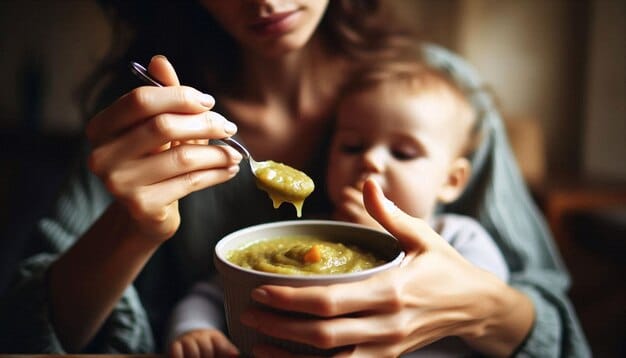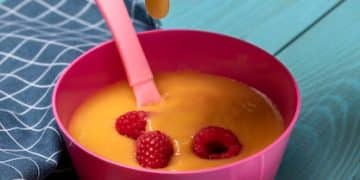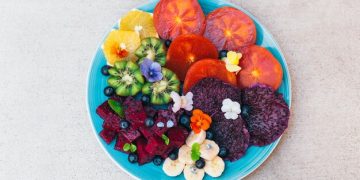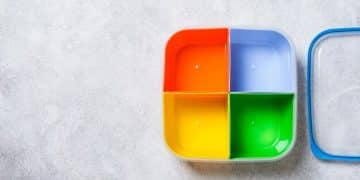Introducing Solids: Your Step-by-Step Guide to Starting Baby Food

Introducing solids to your baby at 6 months is a significant milestone. This guide offers a comprehensive, step-by-step approach, ensuring a smooth transition and setting the stage for a lifetime of healthy eating habits for your little one.
Embarking on the journey of introducing solids: a step-by-step guide to starting your baby on solid foods at 6 months is an exciting milestone for both you and your little one. This transition marks a significant shift in your baby’s nutritional intake and opens a world of new flavors and textures.
When to Start Introducing Solids
Knowing when to begin introducing solids is crucial for your baby’s health and development. Starting too early or too late can present potential challenges, so recognizing the signs of readiness is key.
Signs of Readiness
Before diving into the world of purees, ensure your baby exhibits several signs of readiness:
- Baby can sit upright: The baby must be able to sit upright with minimal support.
- Good head and neck control: The baby should have good control of their head and neck for proper swallowing.
- Interest in food: The baby may start watching you eat with great interest, possibly even reaching for your food.
- Lost tongue-thrust reflex: The baby is no longer automatically pushing food out of their mouth with their tongue.
Consulting Your Pediatrician
Always consult with your pediatrician before introducing solids. They can provide personalized advice based on your baby’s specific developmental needs and any potential allergies or sensitivities. Consider it a crucial step in the journey of introducing solids: a step-by-step guide to starting your baby on solid foods at 6 months.

Observing these readiness signs ensures you’re setting the stage for a positive and healthy experience when introducing solids.
First Foods to Introduce
Selecting the right first foods is important for your baby’s digestive system and overall acceptance of solids. Here’s a simple breakdown to help you choose:
Single-Ingredient Purees
Start with single-ingredient purees to identify any potential allergies. Introduce one new food every 3-5 days.
Recommended First Foods
Some excellent first food choices include thoroughly cooked and pureed:
- Avocado: Rich in healthy fats and easy to digest.
- Sweet Potato: Naturally sweet and packed with nutrients.
- Butternut Squash: Mild and creamy, a good source of vitamins.
- Iron-Fortified Cereal: Often rice cereal, mixed with breast milk or formula.
Choosing these foods is a fundamental aspect when introducing solids: a step-by-step guide to starting your baby on solid foods at 6 months.
Avoid Certain Foods
Avoid foods that are common allergens or choking hazards. For example:
- Honey: Not safe for babies under one year due to the risk of botulism.
- Grapes: Choking hazard.
- Hard vegetables: Such as raw carrots, also a choking hazard.
- Cow’s Milk: Not recommended as a primary drink until one year, but can be used in cooking.
By choosing the right first foods and avoiding potential hazards, you’re setting a safe and healthy course for your baby’s nutritional journey.
Preparing Homemade Baby Food
Making your own baby food is simpler than you might think, and it allows you to control the ingredients and nutritional content. It is also key when introducing solids: a step-by-step guide to starting your baby on solid foods at 6 months.
Steaming and Pureeing
Steaming vegetables and fruits is the best way to retain their nutrients. After steaming, use a food processor or blender to puree the food until it reaches a smooth consistency.
Storing Homemade Baby Food
Store homemade baby food in the refrigerator for up to 3 days or in the freezer for up to 3 months. Use ice cube trays to freeze small portions.
Sample Recipes
Here are two simple recipes to get you started:
- Sweet Potato Puree: Steam diced sweet potato until tender, then puree until smooth.
- Avocado Puree: Mash ripe avocado until smooth—no cooking required.
Preparing homemade baby food not only gives you control over ingredients but also helps you introduce a variety of flavors and textures early on.
Feeding Techniques and Tips
Mastering the art of feeding can make the transition to solids smoother for both you and your baby.
Start Small
Begin with just a spoonful or two of puree. Focus on letting your baby explore the new flavor and texture without pressure. More importantly, focus on introducing solids: a step-by-step guide to starting your baby on solid foods at 6 months.
Be Patient
It may take multiple attempts for your baby to accept a new food. Babies often need time to adjust, so don’t give up after the first try. Try again in a few days.
Create a Routine
Establish a regular feeding schedule. Offering solids at the same time each day can help your baby adjust and anticipate meal times.

By using these feeding techniques, you can help your baby develop a positive relationship with food and enjoy the process of exploring new flavors.
Addressing Common Concerns
Parents often have questions and concerns when introducing solids. Here are some common issues and how to handle them:
Constipation
If your baby becomes constipated, offer prune puree or increase their fluid intake. If constipation persists, consult your pediatrician.
Allergic Reactions
Watch for any signs of an allergic reaction, such as rash, hives, vomiting, or diarrhea. Introduce new foods one at a time to make it easier to identify potential allergens.
Choking Hazards
Always supervise your baby during meal times and avoid giving them foods that are choking hazards. Cut foods into small, manageable pieces.
Being prepared to address these common concerns can help you navigate the early stages of introducing solids with confidence.
Moving Beyond Purees
As your baby gets more comfortable with purees, you can start introducing new textures and flavors to continue introducing solids: a step-by-step guide to starting your baby on solid foods at 6 months.
Introducing New Textures
Around 7 to 8 months, you can start offering mashed or soft-cooked foods. This helps your baby develop their chewing skills.
Expanding the Flavor Palette
Introduce a wider variety of fruits, vegetables, and proteins. Experiment with different combinations to find out what your baby enjoys.
Finger Foods
Offer small, soft finger foods like cooked carrot sticks or banana slices. Make sure they’re easy for your baby to hold and won’t pose a choking hazard. This also supports introducing solids: a step-by-step guide to starting your baby on solid foods at 6 months.
By gradually introducing new textures and flavors, you’re helping your baby develop a well-rounded diet and healthy eating habits.
| Key Point | Brief Description |
|---|---|
| 👶 Readiness Signs | Sit upright, head control, interest in food. |
| 🍎 First Foods | Single-ingredient purees like avocado, sweet potato. |
| 🥣 Feeding Tips | Start small, be patient, create a routine. |
| 🚫 Avoid | Honey, grapes, hard vegetables, cow’s milk. |
Frequently Asked Questions
▼
Look for signs like good head and neck control, the ability to sit upright, showing interest in food by watching you eat, and losing the tongue-thrust reflex.
▼
Start with single-ingredient purees like avocado, sweet potato, or butternut squash. Introduce one new food every 3-5 days to watch for allergic reactions.
▼
Begin with just one or two spoonfuls of puree per feeding. Focus on letting your baby explore the texture and taste without any pressure to eat more.
▼
Don’t force it! It may take multiple attempts for your baby to accept a new food. Try again in a few days. Always make feeding time a relaxed, positive experience.
▼
Yes, absolutely! Homemade baby food is a healthy and economical option. Steam or cook the food and then puree it until smooth. Store it properly in the refrigerator or freezer.
Conclusion
Introducing solids: a step-by-step guide to starting your baby on solid foods at 6 months is a significant milestone in your baby’s development. By following these guidelines and remaining patient and attentive to your baby’s cues, you can ensure a smooth and enjoyable transition for both you and your little one.





